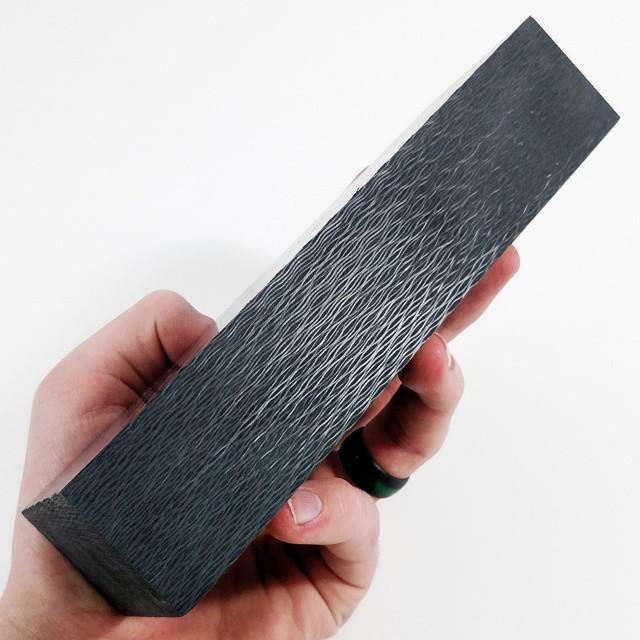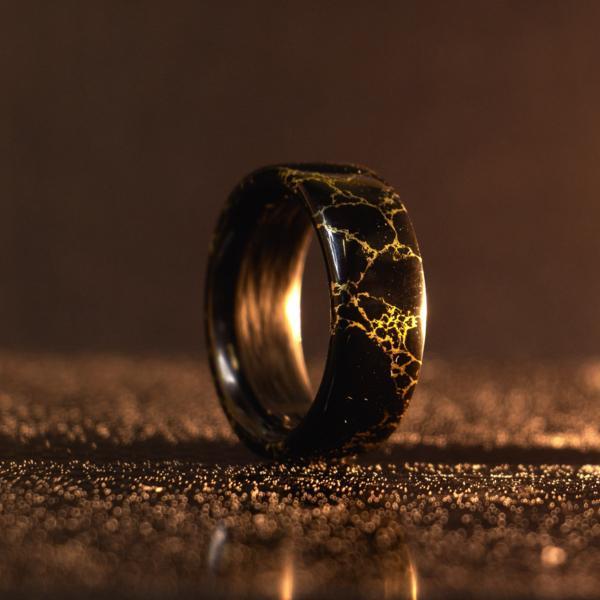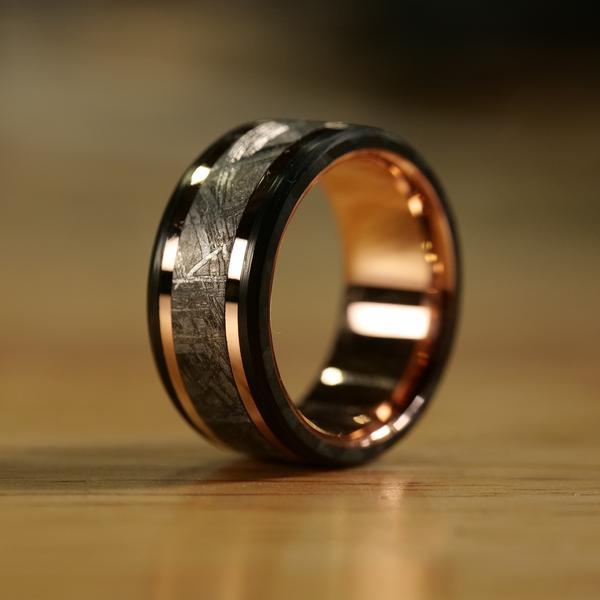What is Carbon Fiber?

What is Carbon Fiber?
What is Carbon Fiber? Everybody knows it exists, but not a lot of people really know what it is, what it's made of, and what it offers to the world. Carbon Fiber Material is often used for industrial grade purposes, but creativity and sheer ingenuity have proven to us that heavy duty materials much like carbon fiber can be crafted into elegant trinkets that add a touch of charisma to your everyday life. The newly discovered polymer is on the rise to fame in the jewelry industry and we are here to shed more light to the already wondrous material. Buckle your seatbelts as things may get quite technical in our little crash course to carbon fiber!
History of Carbon Fiber
The history of carbon fiber is full of constant trial, error, and revision. Despite its initial debut in the 1860s, carbon fibers are popularly known for being used as filaments by Thomas Edison in one of the first incandescent light bulbs to be powered by electricity. Its resistance to heat was what boosted the material's fame among scientists and science enthusiasts.
Multiple processes to manufacture higher quality carbon fiber composites have taken place throughout history to get to where it is today. In 1958, Robert Bacon attempted to produce carbon fiber that consisted of only 20% carbon content, resulting in a product that was too low in strength and stiffness properties. Another attempt was made in the early 1960s by Dr. Akio Shindo from Japan, producing a carbon fiber that consisted of 55% carbon, and another attempt 3 years later was made by W. Watt, L. N. Phillips, and W. Johnson that produced a carbon fiber that was much stronger than any of the ones made in previous manufacturing processes.
People began to see the value carbon fibers can offer to the world at large, that carbon fibers produced today have surpassed their predecessors in terms of quality. Since the 1970s, multiple types of carbon fiber have been developed and are continually being sold in markets and used in various industries up to this day.
The history of carbon fiber is full of constant trial, error, and revision. Despite its initial debut in the 1860s, carbon fibers are popularly known for being used as filaments by Thomas Edison in one of the first incandescent light bulbs to be powered by electricity. Its resistance to heat was what boosted the material's fame among scientists and science enthusiasts.
Multiple processes to manufacture higher quality carbon fiber composites have taken place throughout history to get to where it is today. In 1958, Robert Bacon attempted to produce carbon fiber that consisted of only 20% carbon content, resulting in a product that was too low in strength and stiffness properties. Another attempt was made in the early 1960s by Dr. Akio Shindo from Japan, producing a carbon fiber that consisted of 55% carbon, and another attempt 3 years later was made by W. Watt, L. N. Phillips, and W. Johnson that produced a carbon fiber that was much stronger than any of the ones made in previous manufacturing processes.
People began to see the value carbon fibers can offer to the world at large, that carbon fibers produced today have surpassed their predecessors in terms of quality. Since the 1970s, multiple types of carbon fiber have been developed and are continually being sold in markets and used in various industries up to this day.
How Carbon Fiber is Made
Okay, this is where things are going to get technical. Making carbon fiber is quite complex but we are going to dumb it down for you.
Carbon fiber is made from organic materials, which are composed of long strings of molecule held together by carbon atoms. The majority of carbon fibers are made from the polyacrylonitrile process. Roughly 10% of the material is manufactured from rayon or the petroleum pitch process.
Okay, this is where things are going to get technical. Making carbon fiber is quite complex but we are going to dumb it down for you.
Carbon fiber is made from organic materials, which are composed of long strings of molecule held together by carbon atoms. The majority of carbon fibers are made from the polyacrylonitrile process. Roughly 10% of the material is manufactured from rayon or the petroleum pitch process.
Okay, this is where things are going to get technical. Making carbon fiber is quite complex but we are going to dumb it down for you.
Carbon fiber is made from organic materials, which are composed of long strings of molecule held together by carbon atoms. The majority of carbon fibers are made from the polyacrylonitrile process. Roughly 10% of the material is manufactured from rayon or the petroleum pitch process.
Properties of Carbon Fiber
Carbon fiber is sometimes referred to as the "wonder material" and for good reason. You can also get different patterns of carbon fiber, such as twill weave and forged carbon fiber. We have provided a list below as to why! Properties of carbon fiber include:
- Stronger than steel -Carbon Fiber has a tensile strength 8 times high than Steel
- Light weight despite its strength
- High chemical resistance
- High tolerance to excessive heat
- Tough, making it durable against wear and tear
- It is also not prone to degrade over time or in poor conditions.
- It is flexible and easy to shape into complex designs
- Low in thermal expansion, thus maintaining its shape even when exposed to varying temperatures.
Carbon fiber is sometimes referred to as the "wonder material" and for good reason. We have provided a list below as to why! Properties of carbon fiber include:
- Stronger than steel -Carbon Fiber has a tensile strength 8 times high than Steel
- Light weight despite its strength
- High chemical resistance
- High tolerance to excessive heat
- Tough, making it durable against wear and tear
- It is also not prone to degrade over time or in poor conditions.
- It is flexible and easy to shape into complex designs
- Low in thermal expansion, thus maintaining its shape even when exposed to varying temperatures.
Applications of Carbon Fiber
Because of the plethora of properties carbon fiber possesses, it comes to no one’s surprise that the polymer’s range covers a wide expanse of industries. The Aircraft industry, automobile industry, aerospace, transportation, electrical even to sporting equipment and technology, the many faces of carbon fiber sure are no joke. Carbon fiber can be used for:
- Support structures and aircraft brakes in the aerospace industry
- Bicycle parts
- A common material for race cars and other car parts
- Sporting equipment such as golf shafts, bats, skis, and fishing rods
- Dampening vibration in loudspeakers and various other audio equipment
- The medical field as surgical and x-ray equipment, implants, tendon and ligament repairs
- Aesthetics as pieces of jewelry, particularly rings
Because of the plethora of properties carbon fiber possesses, it comes to no one’s surprise that the polymer’s range covers a wide expanse of industries. The Aircraft industry, automobile industry, aerospace, transportation, electrical even to sporting equipment and technology, the many faces of carbon fiber sure are no joke. Carbon fiber can be used for:
- Support structures and aircraft brakes in the aerospace industry
- Bicycle parts
- A common material for race cars and other car parts
- Sporting equipment such as golf shafts, bats, skis, and fishing rods
- Dampening vibration in loudspeakers and various other audio equipment
- The medical field as surgical and x-ray equipment, implants, tendon and ligament repairs
- Aesthetics as pieces of jewelry, particularly rings
Because of the plethora of properties carbon fiber possesses, it comes to no one’s surprise that the polymer’s range covers a wide expanse of industries. The Aircraft industry, automobile industry, aerospace, transportation, electrical even to sporting equipment and technology, the many faces of carbon fiber sure are no joke. Carbon fiber can be used for:
- Support structures and aircraft brakes in the aerospace industry
- Bicycle parts
- A common material for race cars and other car parts
- Sporting equipment such as golf shafts, bats, skis, and fishing rods
- Dampening vibration in loudspeakers and various other audio equipment
- The medical field as surgical and x-ray equipment, implants, tendon and ligament repairs
- Aesthetics as pieces of jewelry, particularly rings
Carbon fiber is not usually known for being used in jewelry, but since it is incredibly easy to work with and extremely durable, it makes for a great jewelry piece. We’d like to think that with our innovation and our creativity over at Patrick Adair Designs, we can produce high quality carbon fiber rings that are not only durable for everyday wear, but are also lightweight, beautiful and at an affordable price.
Pure Carbon Fiber Ring
One of our crowd favorites and the very ring that started this entire business, the Pure Carbon Fiber Ring comes in a sleek black color with a shiny and polished finish, great for those who enjoy sophistication without the flashiness. Made out of aerospace grade carbon fiber, the ring provides a simple yet classic design that can easily be customized to your liking! Its comfort fit alongside its lightweight properties makes it comfortable to wear that you’ll barely even notice that you have the ring on!
One of our crowd favorites and the very ring that started this entire business, the Pure Carbon Fiber Ring comes in a sleek black color with a shiny and polished finish, great for those who enjoy sophistication without the flashiness. Made out of aerospace grade carbon fiber, the ring provides a simple yet classic design that can easily be customized to your liking! Its comfort fit alongside its lightweight properties makes it comfortable to wear that you’ll barely even notice that you have the ring on!
Carbon Fiber Heretic
Our Carbon Fiber Heretic makes use of a carbon fiber foundation and a TruStone exterior for a durable ring that displays streaks of a vein-like motif in gold. Each ring possesses its own unique golden pattern, making no two rings ever the same. Its dark color matched with the random flashes of gold is a striking yet alluring contrast fitting for strong personalities that like to stand out. Its design is simple yet versatile enough to enhance and match outfits fitting for the everyday as well as nights out!
Our Carbon Fiber Heretic makes use of a carbon fiber foundation and a TruStone exterior for a durable ring that displays streaks of a vein-like motif in gold. Each ring possesses its own unique golden pattern, making no two rings ever the same. Its dark color matched with the random flashes of gold is a striking yet alluring contrast fitting for strong personalities that like to stand out. Its design is simple yet versatile enough to enhance and match outfits fitting for the everyday as well as nights out!
Our Carbon Fiber Heretic makes use of a carbon fiber foundation and a TruStone exterior for a durable ring that displays streaks of a vein-like motif in gold. Each ring possesses its own unique golden pattern, making no two rings ever the same. Its dark color matched with the random flashes of gold is a striking yet alluring contrast fitting for strong personalities that like to stand out. Its design is simple yet versatile enough to enhance and match outfits fitting for the everyday as well as nights out!
Meteorite and Carbon Fiber Ring with Rose Gold Liner
Our Meteorite and Carbon Fiber Ring with Rose Gold Liner is a stunning mix of strength, durability, uniqueness and elegance. Featuring an inlay of the ever so special Widmanstatten pattern that is exclusive only to the Muonionalusta meteorite lined with a real 10k karat gold, this carbon fiber ring exudes nothing more than quality and class at its absolute finest, fitting for those who like to add a touch of sophistication and glamour to their outfits.
Our Meteorite and Carbon Fiber Ring with Rose Gold Liner is a stunning mix of strength, durability, uniqueness and elegance. Featuring an inlay of the ever so special Widmanstatten pattern that is exclusive only to the Muonionalusta meteorite lined with a real 10k karat gold, this carbon fiber ring exudes nothing more than quality and class at its absolute finest, fitting for those who like to add a touch of sophistication and glamour to their outfits.






























